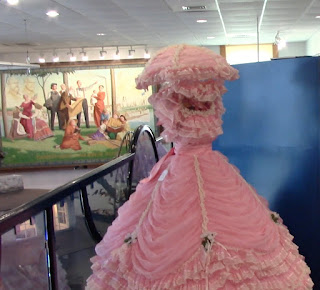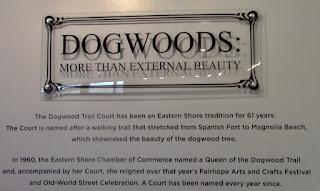Fairhope, Alabama
 |
| Dogwood trail now in bloom. |
NEW EXHIBIT OPENING AT MUSEUM
Young ladies of the current Dogwood Trail Court will be greeting visitors to a new exhibit about the origins of their organization Saturday at the city's Museum of History, 24 N. Section Street, from 11 AM until 1 PM.
According to the exhibit, "the Dogwood Trail has been a tradition on the Eastern Shore for 61 years ... a trail that stretched from Spanish Fort to Magnolia Beach south of Fairhope (generally along Scenic Hwy 98) which showcased the beauty of the dogwood."
"In 1960, the Eastern Shore Chamber of Commerce named a Dogwood Queen and Court for the first time to reign over the Arts & Crafts Festival; one has been named ever since."
The Dogwood Trail began as an offshoot of the larger Azalea Trail that began in Mobile in the 1920's. The Eastern Shore Jaycees became sponsors for the event in 1964; later in the 1970's it became the Optimists Club's event.
MANY DOGWOOD TREES PLANTED
Hundreds of dogwood trees were planted along the route by residents and various civic organizations over the years, but only a few survive today, the victim of disease and storms.
We could find only a handful blooming along the route now, one on Magnolia Avenue at Summit Street (pictured at top) and another on South Section Street near the Catholic Church.
There are over 60 species of dogwood around the world, but Cornus florida is native along the Gulf Coast; they were originally called dog trees because of their twisted limbs and hard wood; bark and other parts have been used for herbal medicines, according to the exhibit.
Museum Director Gabriel Gold-Vukson and assistant Courtney Mcdonald prepared the exhibit on the second for of the museum located at 24 North Section Street.
Trail






Comments